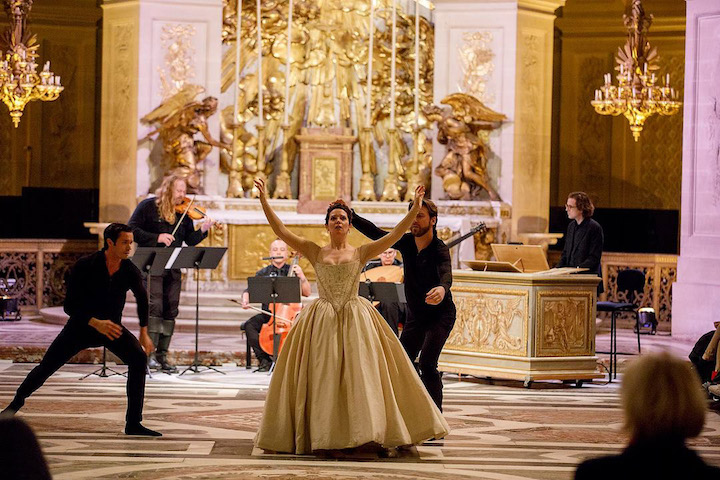The gilets jaunes were rioting again that weekend in Paris. Cars had been set ablaze in upmarket neighbourhoods around Étoile, shop windows smashed, the Arc de Triomphe tagged with angry anti-government slogans. Water cannons and tear gas had been unleashed in an attempt to disperse an estimated 2,000 workers — their numbers reportedly swollen by alt-right infiltrators — enraged by a proposed tax hike on fuel and utilities. Over a hundred protestors and Police nationale had been injured, two hundred more activists placed under arrest. The Champs-Élysées was under siege.
Twenty kilometres southwest of the city, the suburban hamlet of Versailles with its snug allées and cobbled walks bordered by sheltering plane trees seemed a universe removed from the anxious capital. Dominated by the great sprawling Baroque confection that is Louis XIV’s château, the town gleams with enchantment even on a chilly overcast winter’s day. Entering via an imposing porte des artistes, the glorious Opéra Royal stood silent and unearthly before a scheduled Sunday matinee last week.
Folded into a period armchair in the Royal Box, unquestionably one of the most landmark vantage points in opera, Opera Atelier co-artistic director Marshall Pynkoski reflected on the unique trademark aesthetic that has led him and his long-time creative collaborator, partner Jeannette Lajeunesse Zingg, to the fabled, almost 250-year old house. Eyes sparkling, he leans forward as he speaks of his boundless passion for the storied setting.
“The whole thing is like a dream. It never pales. I think perhaps because we don’t live here, when we do come every year and a half or so you just feel you want to absorb every moment. You want to be completely conscious, completely alive. All you want to do is help maintain what all this stands for — the beauty, the excellence.”
Commissioned by Louis XV to celebrate the marriage of his son, the future Louis XVI, to 14-year old Austrian princess Marie Antoinette, the theatre is a monument to courtly Enlightenment values. Baroque starchitect Ange-Jacques Gabriel’s design, decorated by royal sculptor Augustin Pajou and painter Louis Jean-Jacques Durameau, declaims rather than shouts. Stately trompe l’œil effects dominate. Faux marble wooden panelling. An upswept canvas-lined ceiling adorned with a foreshortened scene of Apollo with celestial Muses. Elegantly accented lines of perspective — encircling gilt balconies, mirrored colonnades. Yet for all its grandeur and refinement, an air of palpable bittersweetness hangs over the auditorium, a teardrop of centuries-old sadness locked in a precious jewel box.
Opera Atelier’s swirling Actéon and Pygmalion, meticulously transplanted from Toronto, plays against an ironic background of profound human tragedy, imparting a marked urgency to a production that lives in the heart.
“All of it is ephemeral,” notes Pynkoski with characteristic insight. “But all of it is permeable. The excitement, the love, the anguish that this space has witnessed makes it impossible not to feel that it’s all around us still.”
November/December 2018 marks Opera Atelier’s fifth tour to the Château de Versailles. As tends to be the case wherever this increasingly well-travelled company performs, style is a constant. Ambitious signature works — Médée (2017), Armide (revived 2015), Persée (2014), Armide (2012) — all served to pave the way to solid international acclaim. But the leap across the Atlantic has not been without a degree of on-site theatrical realignment.
Unlike the modest stage house in OA’s Toronto base of operations, the vintage Edwardian-era Elgin Theatre, the Opéra Royal encompasses a much vaster playing area necessitating the use of additional house curtains to frame set designer Gerard Gauci’s painted drops. Even player directions are grand in Versailles, pragmatic nods to the sweeping palace precincts beyond. Cour — stage left. Jardin — stage right. All performance experience at the Château in the 18th century was viewed through a self-referencing regal lens. The legacy of that outlook endures to some extent, requiring more than a little refocusing on the part of visiting OA cast members as Pynkoski is quick to point out.
“Before we began our opening night here, I went to all the dressing rooms and said, ‘Remember everyone. We’re not in Toronto. We’re not in Chicago. You are going to have people who are leaning forward, who are listening, who are watching, who are not making any noise. And we have to get used to the fact that we are playing to a silent house. That doesn’t mean it’s not a responsive house. The response IS the silence. You can’t start overplaying your hand thinking, Oh, they’re not reacting so I have to play harder!’ There is a different perception in France of what the theatre is and why it’s there.”
The outbursts of ample laughter that greeted the overtly comedic moments in Actéon and Pygmalion when it played 6000 km. away on Yonge Street — Actéon’s oversized double take on spying the goddess Diane at her toilette; Galatée’s first clumsy robot-like steps as living statue come to life — may have been a good deal less than forthcoming in Versailles. But the over 8 1⁄2 minutes of rapturous synchronized clapping punctuated by cheers and stamping feet that greeted cast and creators at the close spoke long and loud of an exceptionally attentive audience’s obvious delight.
The act of developing a work from rehearsal to curtain call is a long exhaustive — and exhausting — journey of exploration for Opera Atelier singer actors, dancers and musicians.
“People from other companies often ask, ‘Why such an excessive amount of rehearsal? Aren’t you just wasting time?’ We rehearse from 10:00 in the morning until 10:00 at night.”
Pynkoski sighs, hands flat on armrests.
“It’s all about process. When you work with people that have so much to offer, the work just deepens and deepens and you just want to rehearse more and more and more. You have to keep going back to a scene again and again until you’re not in the picture anymore.”
The desire to communicate the authentic intentions of composer and librettist drives everything in the OA approach to early opera though not to the point of mawkishness or a slavish upholding of historically informed values. Pynkoski has no interest in curating museum pieces.
“I don’t care about being definitive. I want to be coherent,” he emphasizes. “There are many directors who don’t care about telling a story. And I think that’s perfectly legitimate when you look at deconstructionist theatre. They like to say it’s avant-garde but it’s been around for a hundred years. It’s not modern. It’s of a period. I think the most radical thing we as a company can possibly do is try to understand what’s in front of us and tell the story and not say it’s a jumping-off point.”
Judging from the abundance of Château de Versailles Spectacles promotional imagery — program covers, posters, social media posts — derived from Opera Atelier’s brief but impactful residency in the Théâtre Gabriel, Pynkoski’s acutely grounded perspective on Baroque music theatre has found panoramic Gallic appeal. The notion of an all-Canadian opera troupe in the role of upholder of French patrimoine is as remarkable as it is absolute, a validation, surely, of Pynkoski and Lajeunesse Zingg’s vision of early opera as an ageless expression of our ultimate collective humanity.
“I’m astonished and thrilled and flabbergasted,” beams the usually acutely articulate metteur en scène. “I would truly say, the company operates from a place of real love and respect for the repertoire. And for each other.”
Actéon and Pygmalion is the product of that bond, opéra-ballet doubled, strand on strand of emotion twisting and intertwined, simultaneously delicate and enduring. 33 years of daring leaps into a genre few understood and even fewer appreciated, once upon a time, have given Opera Atelier a depth of sensitivity and insight, polish and poise, virtually unequalled anywhere in the world. This is a fairytale band, workers in wonder, wizards and conjurers. The Château de Versailles, that most grandiose of impossible realities, scarcely seemed to contain the enchantment. The artistry of this company is boundless.
Above: Marshall Pynkoski and Jeanette Lajeunesse Zingg watch a rehearsal of Actéon and Pygmalion in the Royal Opera of Versailles. Photo by Bruce Zinger.
Four hours prior to Actéon and Pygmalion’s scheduled curtain rise, in the midst of a driving rainstorm that lashed the vast Cour d’Honneur fronting the palace, Opera Atelier swung open the doors to a very different sort of theatrical event staged in the Château’s soaring Chapelle royale. Fittingly entitled, The Angel Speaks, the one-hour concert, featuring sacred and secular airs by Henry Purcell and William Boyce accompanied by two original contemporary works by Edwin Huizinga, offered what proved to be an emotionally shattering counterpoint to the generally good-natured frivolity of Charpentier and Rameau.
Building on the success of a previous Opera Atelier chamber offering in the Chapel, something of a musical corollary to the company’s 2017 visit to Versailles, music director David Fallis and stage director Marshall Pynkoski filled the divinely Neoclassical space with awe and rapture.
Partnered by a lustrous six-player Baroque ensemble drawn from OA’s touring pit orchestra, Tafelmusik, attended by a fluid cluster of Artists of Atelier Ballet, soprano Mireille Asselin and baritone Jesse Blumberg mesmerized, music and voice rising high into the vaulted nave floating forever through time and space.
A pair of Purcell selections, the first two, the composer’s artful Music for a While succeeded by the lovely measured Entry Dance from The Fairy Queen, opened the program trailed in brisk succession by a crisp, appropriately ceremonious rendition by Asselin and Blumberg of See Nature Rejoicing. A less well known piece, an extract from an overture by Purcell’s 18th century countryman, William Boyce, brought the first half to a bright, resonant close.
And then Huizinga played, solo violin radiant and uplifting, and in that instant all that followed became eternal. Annunciation, a dramatic cantata commissioned by Opera Atelier, text by Austro-Hungarian existentialist author Rainer Maria Rilke from a poem by the same name, cast a transcendent spell. The Archangel Gabriel, danced with stunning grace by Tyler Gledhill, voice embodied to rich effect by Blumberg, lands before the Virgin, dazed, startled, alone. The news he bears is both mystifying and fearful. Together Mother of God and Messenger search for meaning, joined soul to soul by destiny. Segueing to Purcell’s intensely affecting The Blessed Virgin’s Expostulation, Asselin’s poignant phrasing entranced. Inception, a sensuous intermezzo in Actéon and Pygmalion, recontextualized and choreographed here as a ringing expression of living Spirit painted the final panel in the quasi-devotional triptych, Huizinga bearing us heavenwards on long streams of haunting harmony.
Preceded by Purcell’s lovely Trio Sonata in F, the afternoon drew to a close with the gentle joyfulness of An Evening Hymn sung with great sweetness and purity by Asselin.
There are times, all too rare and precious, when song and dance, music and text somehow become one another, creating an experience beyond expression. The Angel Speaks held a capacity audience spellbound.
“For me,” Pynkoski later mused, “it was one of the most profound moments we’ve ever experienced as a company.”
True magic can never be adequately explained.
Opera Atelier will present a repeat performance of The Angel Speaks at the Royal Ontario Museum, Samuel Hall Currelly Gallery, February 21, 2019, 8:00 PM.
Above: Tyler Gledhill, Edwin Huizinga, Mireille Asselin and Jesse Blumberg perform in the Royal Chapel. Photo by Bruce Zinger.



